Here's a picture of the building our new flat is in. We're the third and fourth balconies along on the second floor.
This is Calle Santa Maria. You can see the handsome early 18th century mansion at the end of the street - now a council office.
Our new street, Calle Santa Maria, is both different and similar. It’s also a lively, noisy, drinking street – but this is mainly a more mainstream kind of drinking, with a less radical, youth-focused feel to it – and many are drinking wine as well as beer. There are lots of restaurants on the surrounding streets and several well-known ‘pintxo’ bars on this street. There are lots of older people, and a lot of traditional Basque music-making out on the street, especially groups of older people singing Basque songs in berets! (And this is not for the benefit of tourists, I hasten to add: it’s just what people here do.)
A couple of shots of people drinking at lunchtime (a) outside our front door and (b) below our balcony - and these are relatively quiet times. It gets MUCH busier at weekends and holidays, (By the way, the photo taken from our balcony was taken by a friend: you wouldn't have caught me hanging over the balcony that far...)
Here, going out is not something you do once in a blue moon if you can find a babysitter. It’s so much a part of everyday life that you just take your kids with you; and that includes babies. We’ve often seen whole families sitting in cafes at midnight with baby in pram and children playing. The other side of this coin is that Spanish homes are considered very private places. You don’t invite people in; you go out to meet them.
On some of the less upmarket streets – like our old street Somera – you will find, as well as people drinking on the street outside the bars where they’ve bought their drinks, that there are also young people who have brought their own drinks onto the streets and are whiling away the evening there. They can’t afford (and apparently this is much more common nowadays with the economic crisis) to drink in the bars and clubs, or do the ‘pintxos’ crawls (‘txikiteos’) – and the climate is warm enough that they can just stay out on the streets instead. (Not that moderate amounts of cold or rain would put them off, mind, – it’s very common to see hundreds of people still standing outside drinking in the rain, for instance). They stand outside the shops and houses and bars, or often sit in circles on the (usually cobbled, pedestrianised) street or square, or on the doorsteps of the (closed) shops. It’s all typically gentle – no drunkenness: they drink slowly and punctuate the drinking with food.
At fiesta time, this is particularly common, and throughout town you’ll find groups of young people sitting in circles on the pavements around bottles of coca-cola and wine and spirits that they’ve brought with them.
In various parts of Spain, for instance in Barcelona, ‘El Botellon’ has also apparently occasionally formed the focus of youth unrest and/or political protest, so the authorities see it as a bit of a threat - and apparently, ‘El Botellon’ areas are often highly policed. And of course there are plenty of reasons for young people to feel restive – especially in parts of the country with an unemployment rate of 35%....
Another aspect of the street drinking culture that we’ve noticed is the litter. A huge amount of litter. The litter is extraordinary. People just seem to leave the detritus of hours of drinking and snacking on the street. On Friday and Saturday nights the streets in the Casco Viejo are littered with hundreds of bottles, cans, sunflower-seed husks (the favoured snack while drinking is whole sunflower seeds which people bring bags of, shelling them as they eat) and various other paper things like napkins. After a fiesta, the scene is extraordinary.
But somehow this seems to be an accepted part of the ritual, especially since there are few waste bins on the street. Instead, there’s a massive street-cleaning operation every night. Every night, between 3am and 7 am, ‘Bilbo Garbi’ vans of various sorts come along and clean the streets, and people with hoses come and hose the streets down. Next morning everything is spotless.
This attitude to litter also applies to inside bars. When you order a drink and a ‘pintxo’, you will be given a little napkin; when you pay, you may get a till receipt. It is universally accepted that you will simply drop these bits of paper on the floor by the bar. And there they stay until the end of the evening, when they’re all swept up in one go.
It doesn’t seem to be an indicator of civic carelessness or irresponsibility: it’s just how it’s done. And it’s confined to the ritual of street and bar drinking: it doesn’t mean that everyone’s dropping litter all the time everywhere.
A final word on Spanish street drinking: it goes on for hours. No quick pint at the local before getting on with your busy life. You might start at 8pm and still be there at 2 in the morning. When the fiesta’s on, you might meet up with your friends at 2pm and sit, stand or wander around until 2am, drinking slowly the whole time. Nobody does ‘hanging out’ like the Spanish.
And I’ve never come across people who live in the streets – inhabit and occupy them – to the same extent, even regardless of how cold or wet it is outside. The streets seem to be in full-time use by masses of people – either for strolling and socialising, or for eating or drinking, or for music-making and dancing, or for parades, protests and marches.
Speaking of which, there was a HUGE demonstration – massive – here a couple of weeks ago to demand the return of the ETA prisoners: of which more in a later post.
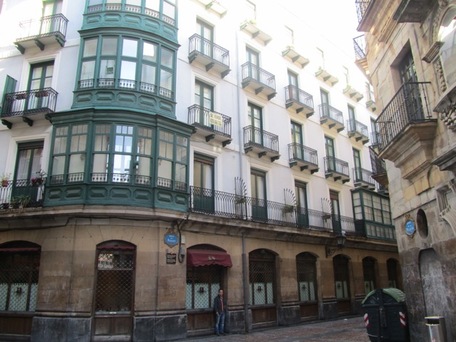

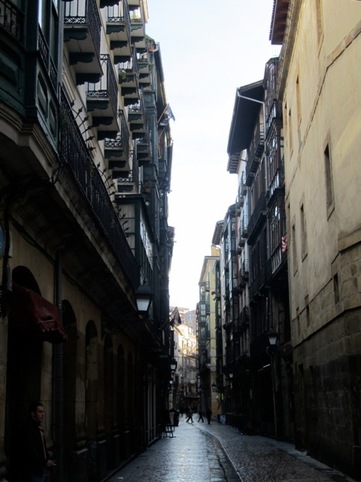
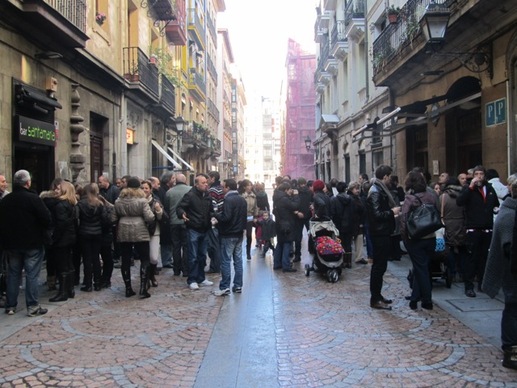
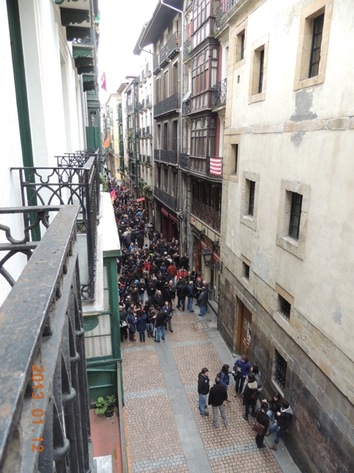
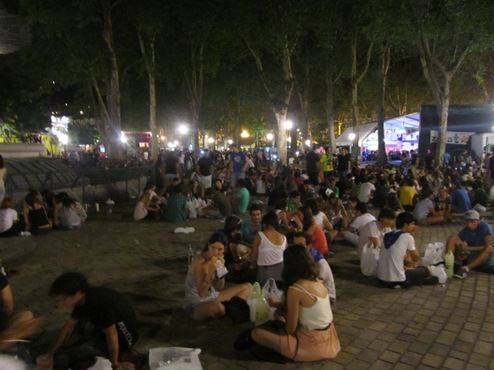
 RSS Feed
RSS Feed